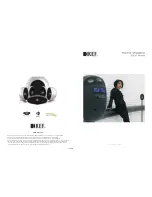
1 Safety Precautions
1.1. GENERAL GUIDELINES
1. When servicing, observe the original lead dress. If a short circuit is found, replace all parts which have been overheated or
damaged by the short circuit.
2. After servicing, see to it that all the protective devices such as insulation barriers, insulation papers shields are properly
installed.
3. After servicing, carry out the following leakage current checks to prevent the customer from being exposed to shock hazards.
1.1.1. LEAKAGE CURRENT COLD CHECK
1. Unplug the AC cord and connect a jumper between the two prongs on the plug.
2. Measure the resistance value, with an ohmmeter, between the jumpered AC plug and each exposed metallic cabinet part on
the equipment such as screwheads, connectors, control shafts, etc. When the exposed metallic part has a return path to the
chassis, the reading should be between 1M
Ω
and 5.2M
Ω
.
When the exposed metal does not have a return path to the chassis, the reading must be
1.1.2. LEAKAGE CURRENT HOT CHECK
1. Plug the AC cord directly into the AC outlet. Do not use an isolation transformer for this check.
2. Connect a 1.5k
Ω
, 10 watts resistor, in parallel with a 0.15µF capacitors, between each exposed metallic part on the set and a
good earth ground such as a water pipe, as shown in Figure 1.
3. Use an AC voltmeter, with 1000 ohms/volt or more sensitivity, to measure the potential across the resistor.
4. Check each exposed metallic part, and measure the voltage at each point.
5. Reverse the AC plug in the AC outlet and repeat each of the above measurements.
6. The potential at any point should not exceed 0.75 volts RMS. A leakage current tester (Simpson Model 229 or equivalent) may
be used to make the hot checks, leakage current must not exceed 1/2 milliamp. In case a measurement is outside of the limits
specified, there is a possibility of a shock hazard, and the equipment should be repaired and rechecked before it is returned to
the customer.
Figure 1
1.2. Before Repair and Adjustment
Disconnect AC power to discharge unit AC Capacitors as such C5700, C5701, C5703, C5704, C5705, C5706, C5707 through a
10
Ω
, 10 W resistor to ground.
Caution:
DO NOT SHORT-CIRCUIT DIRECTLY (with a screwdriver blade, for instance), as this may destroy solid state devices.
After repairs are completed, restore power gradually using a variac, to avoid overcurrent.
Current consumption at AC 230 V~240 V, 50 Hz in NO SIGNAL mode volume minimal should be ~ 600 mA. (EB)
Current consumption at AC 230 V, 50 Hz in NO SIGNAL mode volume minimal should be ~ 600 mA. (E/EG)
1.3. Protection Circuitry
The protection circuitry may have operated if either of the following conditions are noticed:
•
•
•
•
No sound is heard when the power is turned on.
•
•
•
•
Sound stops during a performance.
6
SA-PT560E / SA-PT560EB / SA-PT560EG
Содержание SA-PT560E
Страница 3: ...Refer to their respective original service manuals for 1 3 SA PT560E SA PT560EB SA PT560EG ...
Страница 13: ...13 SA PT560E SA PT560EB SA PT560EG ...
Страница 41: ...41 SA PT560E SA PT560EB SA PT560EG ...
Страница 43: ...9 2 Main Components and P C B Locations 43 SA PT560E SA PT560EB SA PT560EG ...
Страница 65: ...65 SA PT560E SA PT560EB SA PT560EG ...
Страница 90: ...SA PT560E SA PT560EB SA PT560EG 90 ...
Страница 100: ...100 SA PT560E SA PT560EB SA PT560EG ...
Страница 131: ...CN5501 Fig 3 Fan Connector 131 SA PT560E SA PT560EB SA PT560EG ...
Страница 141: ...24 Exploded Views 24 1 Cabinet Parts Location SA PT560E SA PT560EB SA PT560EG 141 ...
Страница 142: ...24 2 Packaging SA PT560E SA PT560EB SA PT560EG 142 ...







































